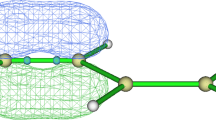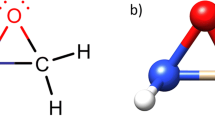Abstract
A positive π-hole is a region of positive electrostatic potential that is perpendicular to a portion of a molecular framework. It is the counterpart of a σ-hole, which is along the extension of a covalent bond to an atom. Both σ-holes and π-holes become more positive (a) in going from the lighter to the heavier atoms in a given Group of the periodic table, and (b) as the remainder of the molecule is more electron-withdrawing. Positive σ- and π-holes can interact in a highly directional manner with negative sites, e.g., the lone pairs of Lewis bases. In this work, the complexes of 13 π-hole-containing molecules with the nitrogen lone pairs of HCN and NH3 have been characterized computationally using the MP2, M06-2X and B3PW91 procedures. While the electrostatic interaction is a major driving force in π-hole bonding, a gradation is found from weakly noncovalent to considerably stronger with possible indications of some degree of coordinate covalency.

Computed molecular surface electrostatic potential of SeO2 showing the π-hole above the selenium atom (middle). The position of the most positive electrostatic potential associated with the π-hole is indicated by a black hemisphere. Color ranges, in kcal mol-1, are: red, greater than 33; yellow, from 33 to 20; green, from 20 to 0; blue, less than 0 (negative).



Similar content being viewed by others
References
Clark T, Henneman M, Murray JS, Politzer P (2007) J Mol Model 13:291–296
Brinck T, Murray JS, Politzer P (1992) Int J Quantum Chem 44:55–64
Auffinger P, Hays FA, Westhof E, Ho PS (2004) Proc Natl Acad Sci USA 101:16789–16794
Politzer P, Lane P, Concha MC, Ma Y, Murray JS (2007) J Mol Model 13:305–311
Politzer P, Murray JS, Clark T (2010) Phys Chem Chem Phys 12:7748–7757
Stevens ED (1979) Mol Phys 37:27–45
Nyburg SC, Wong-Ng W (1979) Proc R Soc Lond A 367:29–45
Ikuta S (1990) J Mol Struct THEOCHEM 205:191–201
Price SL, Stone AJ, Lucas J, Rowland RS, Thornley AE (1994) J Am Chem Soc 116:4910–4918
Tsirelson VG, Zou PF, Tang T-H, Bader RWF (1995) Acta Crystallogr A 51:143–153
Lommerse JPM, Stone AJ, Taylor R, Allen FH (1996) J Am Chem Soc 118:3108–3116
Grabowski SJ, Bilewicz E (2006) Chem Phys Lett 427:51–55
Murray JS, Lane P, Clark T, Politzer P (2007) J Mol Model 13:1033–1038
Murray JS, Lane P, Politzer P (2007) Int J Quantum Chem 107:2286–2292
Murray JS, Lane P, Politzer P (2009) J Mol Model 15:723–729
Politzer P, Murray JS (2009) In: Leszczynski J, Shukla M (eds) Practical Aspects of Computational Chemistry. Springer, Heidelberg, pp 149–163
Murray JS, Riley KE, Politzer P, Clark T (2010) Aust J Chem 63:1598–1607
Riley KE, Murray JS, Concha MC, Politzer P, Hobza P (2009) J Chem Theor Comput 5:155–163
Shields ZP, Murray JS, Politzer P (2010) Int J Quantum Chem 110:2823–2832
Riley KE, Murray JS, Fanfrlík J, Řezáč J, Solá RJ, Concha MC, Ramos FM, Politzer P (2011) J Mol Model, doi:10.1007/s00894-011-1015-6
Sjoberg P, Politzer P (1990) J Phys Chem 94:3959–3961
Stewart RF (1979) Chem Phys Lett 65:335–342
Politzer P, Truhlar DG (eds) (1981) Chemical Applications of Atomic and Molecular Electrostatic Potentials. Plenum Press, New York
Naray-Szabo G, Ferenczy GG (1995) Chem Rev 95:829–847
Politzer P, Murray JS (2002) Theor Chem Acc 108:134–142
Murray JS, Politzer P (2011) Rev Comput Mol Sci 1:153–163
Bader RFW, Carroll MT, Cheeseman JR, Chang C (1987) J Am Chem Soc 109:7968–7979
Murray JS, Politzer P (2009) Croat Chem Acta 82:267–275
Frisch MJ et al. (2009) Gaussian 09. Gaussian Inc, Wallingford, CT
Bulat FA, Toro-Labbé A, Brinck T, Murray JS, Politzer P (2010) J Mol Model 16:1679–1691
Zhao Y, Truhlar DG (2008) Theor Chem Acc 120:215–241
Grimme S (2006) J Comput Chem 27:1787–1799
Bondi A (1964) J Phys Chem 64:441–451
Riley KE, Hobza P (2007) J Phys Chem A 111:8257–8263
Riley KE, Pitoňák M, Černy J, Hobza P (2010) J Chem Theor Comput 6:66–80
Johnson ER, Wolkow RA, DiLabio GA (2004) Chem Phys Lett 394:334–338
Mohan N, Vijayalakshmi KP, Koga N, Suresh CH (2010) J Comput Chem 31:2874–2882
Murray JS, Concha MC, Lane P, Hobza P, Politzer P (2008) J Mol Model 14:699–704
Politzer P, Murray JS, Bulat FA (2010) J Mol Model 16:1731–1742
Politzer P, Huheey JE, Murray JS, Grodzicki M (1992) J Mol Struct THEOCHEM 259:99–120
Politzer P, Murray JS, Lane P, Concha MC (2009) Int J Quantum Chem 109:3773–3780
Murray JS, Lane P, Nieder A, Klapötke TM, Politzer P (2010) Theor Chem Acc 127:345–354
Ignatyev IS, Schaefer HF III (2001) J Phys Chem A 105:7665–7671
Del Bene JE, Alkorta I, Elguero J (2010) J Phys Chem A 114:12958–12962
Lide DR (ed) (1997) Handbook of Chemistry and Physics, 78th edn. CRC, Boca Raton, FL
Brinck T, Murray JS, Politzer P (1993) Inorg Chem 32:2622–2625
Acknowledgments
TC gratefully acknowledges the generous support of the Deutsche Forschungsgemeinschaft as part of SFB583 (Sonderforschungsbereich 583) “Redox-Active Metal Complexes: Control of Reactivity in Molecular Architecture” and KER the NSF (National Science Foundation) EPSCOR (Experimental Program to Stimulate Competitive Research) Program (Grant number EPS-0701525) and the NSF PREM (Partnership for Research & Education in Materials) Program (Grant number DMR-0934115).
Author information
Authors and Affiliations
Corresponding author
Rights and permissions
About this article
Cite this article
Murray, J.S., Lane, P., Clark, T. et al. σ-Holes, π-holes and electrostatically-driven interactions. J Mol Model 18, 541–548 (2012). https://doi.org/10.1007/s00894-011-1089-1
Received:
Accepted:
Published:
Issue Date:
DOI: https://doi.org/10.1007/s00894-011-1089-1




